Slow Feuilletage

A few days ago, I was planning to have a dinner party and while on the Quai St. Antoine, I saw the man who comes down some days from the Jura mountains. Amid various mountain cheeses, he had a slab of raw butter. After asking his price, which when calculated in my mind cost slightly more than your average supermarket butter, but less than the haut gamme butters in mass distribution, I asked for a taste. Light, unsalted, complex as it flowered on my tongue, it sold itself to me easily. I bought a kilo. While he wedged off two large chunks that miraculously enough came out to weigh about 500 grams each, he told me that the butter he was selling me had been made at the farm just the day before. Walking back home, I wondered at the deliciousness that this raw butter made just the previous day would produce in my home made pastry.
Having my recipe for fast feuilletage already in your notebook, I thought I'd share a few ideas and a reminder that puff pastry rolled out at home tastes far superior to anything you can find in the store and quite possibly better than you can get from the neighborhood bakery. It's all about the butter. When I talk about good butter, I don't mean some technical quality that one or another butter might have, but the flavor of the butter. A butter that tastes good makes excellent puff pastry.
Puff pastry has got such a bad rap. I just don't know what to say when people say they can't bring themselves to do it. After all, I used to be one of those people. Oh the things I never dared to do! But after some risk taking and realization that it isn't nearly as easy to mess up as people say it is, I felt like I was in on a kind of secret. One of the most wonderful things about puff pastry is that it freezes very well. Instead of hours of hard labor, hands-on time is more like 15 minutes, in little pleasurable bursts interspersed over an evening. If you have a kitchen timer and a little counter space or a table, you can easily fit feuilletage between cooking dinner, bathing children, story time, reading a book, catching up on your e-mails, or talking on the phone. It fits into normal family contemporary lifestyles, and can make a huge difference in your inclination to invite people over at a moment's notice, because you'll be able to serve really great tasting and beautiful feuilletage-based creations if you already have the good kind ready in your freezer.
What can you do with feuilletage? For starters, I suggest taking a good look at the many recipes that require pre-fab puff pastry. Next, know that you don't need recipes to have fun with puff pastry. You can roll things up in it and slice them, make matchsticks and spread them with things before baking, use leftovers, cut shapes with cookie cutters, make sweet desserts, tartes, classic millefeuilles, and hundreds of other things just by using your imagination.
Last night I had dinner out, and enjoyed a first course of this season's asparagus, roquefort and thin sliced cured ham layered between two little rectangular wedges of feuilletage. The asparagus had been cooked in advance, and this first course was constructed and placed in the oven just long enough for the cheese to melt and the pastry to puff, crispen and brown on top. It was a delicious combination and will be even better with my own pastry. I plan to do a variation on that very soon as a first course for friends.
In the meantime, I have a freezer full of tapenade rolls ready to bake, and several blank slates ready for just about anything. There are so many things, sweet or savory, that you can do with this pastry dough. Use the kitchen scale for this and weigh the water too.
Recipe: Slow Feuilletage
500 grams flour
12 grams finely ground sea salt
300 grams water
400 grams butter, chilled
Place the flour and salt in a bowl and make a well in the center. Pour the water in and work it into a smooth homogenous dough. Work the dough with your hands to get it nice and smooth, place it in a ziplock or wrap it in plastic wrap and place this dough into the refrigerator to rest for 30 minutes.

Notice the rounded ends are tucked under at first.
You don't have to do this but it makes things roll out more squarely.
Remove the dough from the wrap and lightly flour your counter surface. Roll the dough about 1 inch thick and then with the rolling pin roll out four edges to form flaps that you will fold over the butter. Once you have done that, remove the butter from the refrigerator, and place it on a big sheet of freezer paper or baking parchment, fold the paper over it to protect the rolling pin from getting greasy, and pound the butter with the rolling pin into a flat piece that will fit easily into the center of the dough. Fold the edges you have created over the butter in the center. Now, you are ready to roll it out.
Roll this mound of dough folded over your butter out flat into an oblong rectangle. Now fold this rectangle into thirds, turn it a quarter turn, and roll it out again. Fold and roll once again, then place this into the refrigerator to chill for 40 minutes.
Repeat this folding into thirds process 2 more times, for a total number of folding and rolling of 6 times. From there, you can place it back in the refrigerator to be ready when you plan to use it in the next day or two, or put that into the freezer, where it will keep up to three months.
Thanks go to Chef Sylvain Malland of Cuisine et Dependences Acte II, 68 rue de la Charité, in Lyon's 2nd arrondissement for allowing me to take photos of him rolling and folding puff pastry during a coaching cuisine demonstration at Emile Henry.










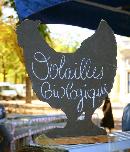
















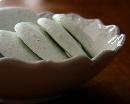








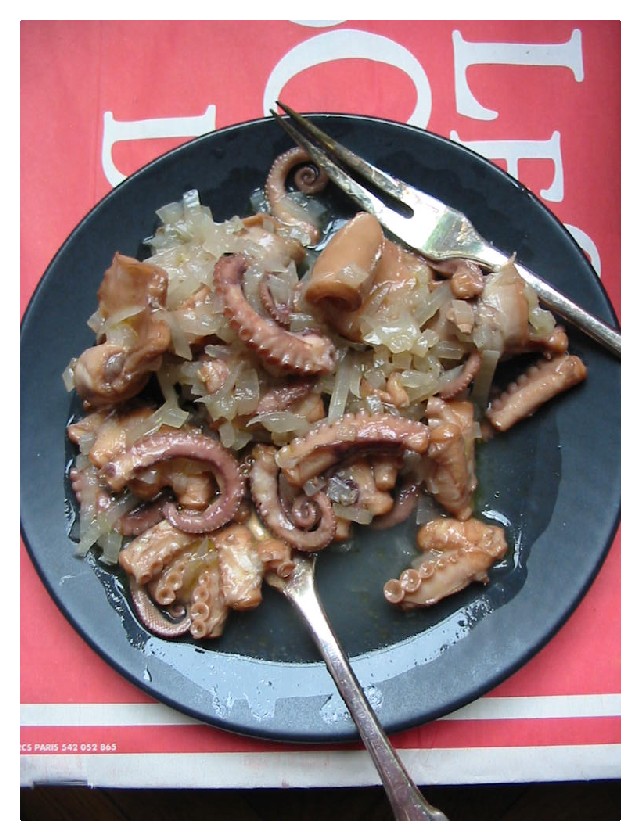


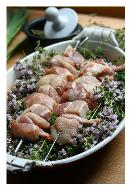












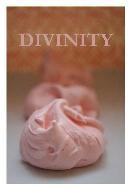
10 Comments:
Thanks for sharing this - it's bookmarked for me to try!
You can make the intricacies of an age seem sublimely simple, and we all get the "I can DO THAT!" feeling from your teaching.
I can see why your classes are so popular---when you get that SPACE, you'll be off and away.
The only thing I miss is the two little dimples on one edge of the package, made by a gentle tap of the knuckles of your first and middle fingers, to indicate the place to start rolling next time.
It was always somehow vital that you not "lose your place," and that's a fond memory I have of watching the process and later making my own.
Have fun, Ruth!
Rachel, I can't wait to get that SPACE!
Yes, folding 6 times and not 4 or 8 gives much better results. I sometimes just dispense with the finger marks but it does make sense to do it when you really want to make sure you're counting correctly.
Fantastic photos! I loved hearing about the butter.
I too have always felt like Puff pastry is too much trouble to make....but not now. You've convinced me to have a go.
First the confit clementines and now puff pastry....next you'll be convincing me to farm geese for foie gras! Thankyou Lucy.
I think you've converted me...
Thanks!
What an advantage to have fresh raw butter! Your instructive photos are clear and make puff pastry seem basic. Reminds me of when I've made croissants.
-Brenda
Must roll up my sleeves and try this! Would you recommend higher fat content butters? (in the US that's 12g vs. 11g)
You know, in my experience, I have not had any significantly different result from the higher fat content butters. I would instead recommend the butter you personally think tastes the best, because the flavor is what is going to make the most difference in your pastry.
I'm addicted to the pre-fab stuff, but you make this sound so easy I'm going to half to try it... But next winter when life settles down again... Bookmarked!
Post a Comment
<< Home